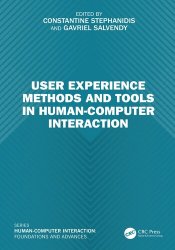User Experience Methods and Tools in Human-Computer Interaction
- Добавил: literator
- Дата: 11-07-2024, 10:09
- Комментариев: 0
 Название: User Experience Methods and Tools in Human-Computer Interaction
Название: User Experience Methods and Tools in Human-Computer InteractionАвтор: Constantine Stephanidis, Gavriel Salvendy
Издательство: CRC Press
Год: 2025
Страниц: 488
Язык: английский
Формат: pdf (true)
Размер: 15.1 MB
This book covers user experience methods and tools in designing user‑friendly products and servicesby encompassing widely utilized successful methods, including elicitation, analysis and establishment of requirements, collaborative idea generation with design teams and intended users, prototype testing and evaluation of the user experience through empirical and non‑empirical means.
This book, titled "User Experience Methods and Tools in Human-Computer Interaction", serves as a comprehensive reference for user experience methods and tools in the design process of user‑friendly products and services. It provides an extensive overview of methods and tools tailored for each stage of the design process, with a primary focus on user research and prototyping. Methods discussed for the active involvement of users in the human‑centered design process entail requirements elicitation, ethnography, user observation, interviews, ideation, focus groups, brainstorming, participatory design, and crowdsourcing in UX research. This book equips readers with a comprehensive toolset for use throughout the design process, ensuring that what is created aligns with user needs and desires. In this regard, this book encompasses chapters on personas, scenarios, journey maps, storyboarding, task analysis and modeling, user modeling, digital human modeling, prototyping techniques, gamification design, and UX design tools. It covers a wide array of research and evaluation methods employed in HCI during design, from the initiation of the human‑centered development cycle to its culmination, elaborating on questionnaires and surveys, inspection methods for usability evaluation, usability testing, as well as eye tracking and physiological measurements for UX evaluation, along with approaches to facilitate user assistance and support. Overall, this book encompasses the most commonly utilized and successful methods, spanning the elicitation, analysis and establishment of requirements, collaborative idea generation with design teams and intended users, prototype testing and the evaluation of the user experience through empirical and non‑empirical means.
What Does User Experience Mean? If we want to examine the UX of a product, we need a clear understanding of this concept. ISO 9241‑210 defines UX as a person’s perceptions and responses that result from the use or anticipated use of a product, system or service. This definition contains several aspects that are relevant for the construction and application of instruments that try to measure UX. First, UX is a subjective perception concerning certain qualities of a product, system, or service (we use, in the following, the term product to refer to all three categories). Thus, there is no objective way to measure UX. We need to ask users of a product about their opinion. This implies that UX is always relative to the target group and context of use of a product. If we ask different persons, their opinions concerning the UX of the same product may differ heavily. The same is true if a product can be used for different usage scenarios. The UX for some usage scenarios may be perceived as poor, while other usage scenarios may create a good UX impression. Another important aspect is that UX is not only influenced by the actual usage experience of a product. It covers also the anticipated use, i.e. expectations toward a product that a person wants to use in the future. Such expectations may even influence the subjective perception of the actual experience when users later start to use the product. This is a clear differentiator to the concept of usability, which is restricted to the actual usage experience.
This book:
• Provides methods and tools tailored for each stage of the design process.
• Discusses methods for the active involvement of users in the human‑centered design process.
• Equips readers with an effective toolset for use throughout the design process, ensuring that what is created aligns with user needs and desires.
• Covers a wide array of research and evaluation methods employed in HCI, from the initiation of the human‑centered development cycle to its culmination.
This book is a fascinating read for individuals interested in Human-Computer Interaction research and applications.
Скачать User Experience Methods and Tools in Human-Computer Interaction
Внимание
Уважаемый посетитель, Вы зашли на сайт как незарегистрированный пользователь.
Мы рекомендуем Вам зарегистрироваться либо войти на сайт под своим именем.
Уважаемый посетитель, Вы зашли на сайт как незарегистрированный пользователь.
Мы рекомендуем Вам зарегистрироваться либо войти на сайт под своим именем.
Информация
Посетители, находящиеся в группе Гости, не могут оставлять комментарии к данной публикации.
Посетители, находящиеся в группе Гости, не могут оставлять комментарии к данной публикации.
